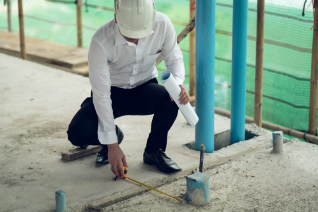When it comes to ensuring structural safety, longevity, and compliance, Non-Destructive Testing (NDT) is an essential tool in the civil engineering toolbox. NDT allows engineers to assess the condition of a building without causing any physical damage, making it ideal for ongoing maintenance, audits, or pre-renovation assessments.
In this guide, we’ll walk you through everything you need to know about NDT testing for buildings — the methods, benefits, and where they are most effectively used.
Non-Destructive Testing for buildings is no longer optional — it’s a necessity. Whether you’re a builder, architect, PMC consultant, or property owner, adopting NDT ensures safety, saves costs, and helps you stay compliant.
What is NDT in Civil Engineering?
Non-Destructive Testing (NDT) refers to a series of testing techniques used to evaluate the material properties, strength, and structural health of a building without altering or destroying any part of the structure.
It is particularly useful in:
- Evaluating existing buildings for safety
- Detecting internal flaws
- Verifying material strength
- Ensuring compliance with IS codes
- Overview of Occupational Safety and Health Administration regulations relevant to construction sites.
Top NDT Testing Methods for Buildings
Here are the most commonly used NDT methods in building inspections:
- Rebound Hammer Test
Purpose: Assess surface hardness of concrete.
Equipment: Schmidt Rebound Hammer
Use Case: Quick evaluation of concrete compressive strength. - Ultrasonic Pulse Velocity (UPV) Test
Purpose: Identify cracks, voids, and non-uniformities.
Use Case: Internal flaw detection in beams, columns, and slabs. - Core Compression Test (Semi-NDT)
Purpose: Actual compressive strength test.
Use Case: Used when historical data is unavailable or needs confirmation. - Rebar Locator/Scanner Test
Purpose: Detect rebar location, diameter, and cover.
Use Case: Before drilling, coring, or structural alterations.
Benefits of Non-Destructive Testing for Buildings
- Damage-Free Assessment: No harm to structural components.
- Accurate Diagnosis: Pinpoints internal issues that may not be visible.
- Cost-Effective: Helps prevent unnecessary repairs or replacements.
- Saves Time: Faster than destructive methods.
- Regulatory Compliance: Aligns with IS 13311 and other relevant standards.
Choosing the Right NDT Testing Partner
- Experience with Swiss Proceq Equipment
- ISO 9001:2015 certified reporting
- Civil engineers with structural audit expertise
- Capability to deliver detailed, easy-to-understand reports
Conclusion
Non-Destructive Testing for buildings is no longer optional — it’s a necessity. Whether you’re a builder, architect, PMC consultant, or property owner, adopting NDT ensures safety, saves costs, and helps you stay compliant.
At Civil Vision Engineering, we offer reliable, certified, and professional NDT testing services across Bangalore and beyond. Contact us for a free consultation or site visit.



